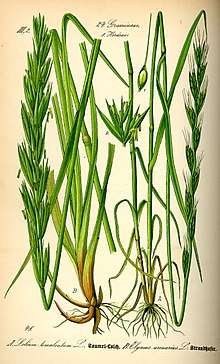Lolium temulentum
Lolium temulentum, typically known as darnel, poison darnel, darnel ryegrass or cockle, is an annual plant of the genus Lolium within the family Poaceae. The plant stem can grow up to one meter tall, with inflorescence in the ears and purple grain. It has a global distribution.
| Lolium temulentum | |
|---|---|
 | |
| Scientific classification | |
| Kingdom: | Plantae |
| Clade: | Tracheophytes |
| Clade: | Angiosperms |
| Clade: | Monocots |
| Clade: | Commelinids |
| Order: | Poales |
| Family: | Poaceae |
| Subfamily: | Pooideae |
| Genus: | Lolium |
| Species: | L. temulentum |
| Binomial name | |
| Lolium temulentum | |
Growth
Darnel usually grows in the same production zones as wheat and was a serious weed of cultivation until modern sorting machinery enabled darnel seeds to be separated efficiently from seed wheat.[1] The similarity between these two plants is so great that in some regions, darnel is referred to as "false wheat".[2] It bears a close resemblance to wheat until the ear appears. The spikes of L. temulentum are more slender than those of wheat. The spikelets are oriented edgeways to the rachis and have only a single glume, while those of wheat are oriented with the flat side to the rachis and have two glumes. Wheat will appear brown when ripe, whereas darnel is black.[3]
Darnel can be infected by an endophytic fungus of the genus Neotyphodium and the endophyte-produced, insecticidal loline alkaloids were first isolated from this plant.[4]
The French word for darnel is ivraie (from Latin ebriacus, intoxicated), which expresses the drunken nausea from eating the infected plant, which can be fatal.[1] The French name echoes the scientific name, Latin temulentus "drunk."
Literary references
The ancient Greek botanist Theophrastus stated in his De causis plantarum (8:7 §1) that wheat can transform (metaballein) into darnel (aira), since fields sown to wheat are often darnel when reaped.[1]
Darnel is mentioned in Horace's Satire 2.6 (eaten by the Country mouse while he serves his guest fancier foods) and may have been the plant in the Parable of the Tares in the Gospel of Matthew:
Let both grow together until the harvest: and in the time of harvest I will say to the reapers, Gather ye together first the tares, and bind them in bundles to burn them: but gather the wheat into my barn.
In ordering the St. Brice's Day massacre of all the Danes in England, Æthelred the Unready observed that "all the Danes who had sprung up in this island, sprouting like cockle amongst the wheat, were to be destroyed by a most just extermination."[5]
Darnel is also mentioned as a weed in Shakespeare's King Lear,[6]
Darnel is one of the many ingredients in mithridate, which Mithridates, the king of ancient Pontus, is supposed to have used every day to render him immune to poisoning.
Darnel is mentioned in the Mishnah in Kilayim (1:1) as זונין (zunin), similar to the Arabic زؤان (zuʾān).[7]
See also
References
- Leroi, Armand Marie (2014). The Lagoon: How Aristotle Invented Science. Bloomsbury. pp. 296–297. ISBN 978-1-4088-3622-4.
- Craig S. Keener, The Gospel of Matthew: A Socio-Rhetorical Commentary, Wm. B. Eerdmans Publishing, 2009 p.387
- Heinrich W.Guggenheimer, The Jerusalem Talmud,Vol. 1, Part 3, Walter de Gruyter, 2000 p.5
- Schardl CL, Grossman RB, Nagabhyru P, Faulkner JR, Mallik UP (2007). "Loline alkaloids: currencies of mutualism". Phytochemistry. 68 (7): 980–996. doi:10.1016/j.phytochem.2007.01.010. PMID 17346759.
- "'COCKLES AMONGST THE WHEAT': DANES AND ENGLISH IN THE WESTERN MIDLANDS IN THE FIRST HALF OF THE ELEVENTH CENTURY". Midland History. 11: 1–22. doi:10.1179/mdh.1986.11.1.1.
- Seager, Herbert West (1896). "Darnel". Natural history in Shakespeare's time. London: Elliot Stock. p. 82.
- Artscroll Kilayim, June 2012